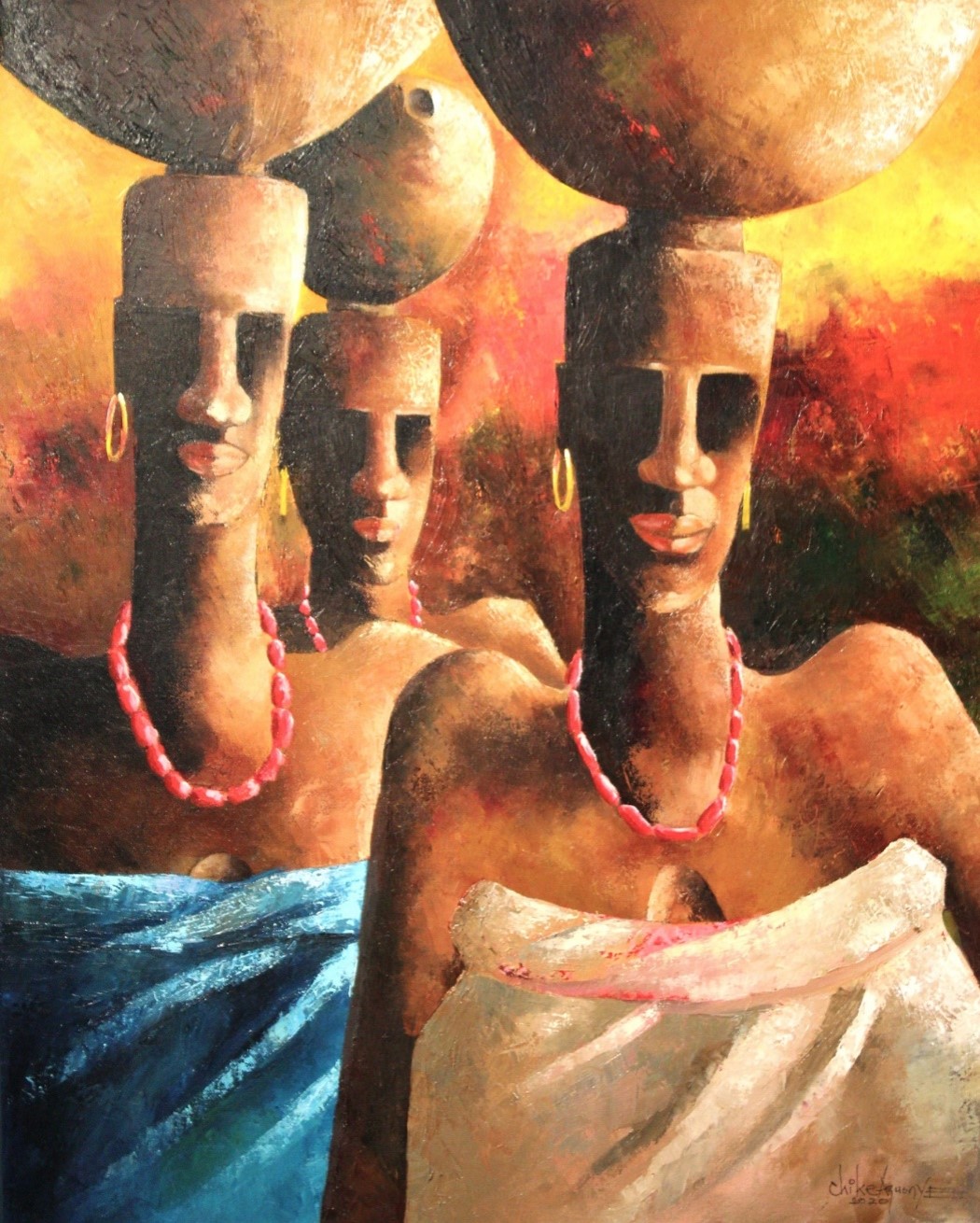Another Glimpse of Paradise - The works of Chike Azuonye
All artists are dreamers, but there are some whose quest for the ultimate dream takes them away, irrevocably, from the here and now. Like Paul Gauguin, the French artist who exiled himself to Melanesia in search of the ideal and capturing the soul of those beautiful islands in such vivid colours that the world for an instant had a glimpse of Paradise, or what it might have looked like, through Gauguin's eyes.
Chike Azuonye is in every sense a modem painter, living and working in London, the art capital of the world. And yet, like Paul Gauguin, he insists on dreaming the world anew- or rather, daydreaming the world of his Nigerian childhood in vivid Technicolor. In evoking an Arcadian past to confront the steel and glass of the European megapolis, Mr Azuonye is walking a well-beaten path, like the writer Camara Laye whose classic story of his Guinean childhood, THE AFRICAN CHILD, provided a refreshing counterpoint to the grey and sombre Paris of his student days.
But it would be grossly misleading to categorise Chike Azuonye as just another home-sick African artist working out his dreams on canvas in a lonely London studio. Azuonye is by choice and inclination a griot of sorts, journeying back to a past when the moon bathed the village green in a cascade of gold and the wily tortoise set out at twilight to conquer the world. These are folk tales of a forgotten past, a past sliding slowly and dangerously toward extinction but which Chike Azuonye has retrieved and captured permanently on canvas.
At first encounter with Azuonye's work, you are immediately struck by the sheer visual power of the canvases. This is one painter who delights in spectacle for the sheer joy of it. He works mainly in oil and acrylic, using the palette knife and applying the colours in layers, cascade upon cascade until the painting begins to gradually take shape and then suddenly explode in a kaleidoscope of dancing images. Mi Azuonye's canvas is a vast tableau of bright reds and indigos and Prussian blues and oranges. They clash and collide and then finally resolve themselves in an orchestra of colours. You see the griot's tale as embodied in the visual images but it is the merry colours that bring Azuonye's stories forcefully to life. He is, first and foremost, a painter of merry colours.
Life as it was lived in Nigeria, a vanishing past which nevertheless retains some of its charm and allure, is Mr Azuonye's terrain. He celebrates northern Nigerian womanhood in a painting that depicts two women scantily clad in wrappers and beads and carrying gourds. The Fulani milkmaid is a favourite subject of Nigerian painters, but in Azuonye's hand the object is relegated to the background and colour is given full play. You do not see the milkmaids as such. Rather you are treated to a visual feast- a brilliant interplay of reds and ambers and oranges. The red and blue wrappers, the beads, the full succulent breasts thrusting out at you in defiant display of their power and beauty-woman in all her glory, these are what Azuonye seeks to celebrate in this picture, using his colours the way an accomplished minstrel uses words to adorn his tale.
In work after work- two drummers on market day, women hurrying to the farm at dawn accompanied by an insomniac moon, a study of musicians and musical instruments Azuonye returns to the past, throwing up symbols of a dying culture- kolanuts, cowries, manilas, and using them, not as exotica but living things that people his canvases, silent witnesses to a life that was once simple and beautiful but is now giving way to the regime of grey steel that Western civilization has imposed on the rest of us. There is dance and merriment and celebration here. But you cannot help but detect the underlying sadness in some of the canvases. It is there in Azuonye's muted blues and indigos, in the grim expression on some of the faces that stare at you as though protesting their dark fate, condemned as they are to vanish from a world that no longer has any use for moonlight tales, for new yam festivals, for truth and beauty.
Chike Azuonye is an artist working in a cultural milieu that has been given over to art as media hype, a society where a pretty lady sleeping in a cage or two cows copulating in a glass case easily passes off as the' latest masterpiece.' Installation and ambiguity is all, and the curator rather than the artist himself is the star personality in the new circus show. But Azuonye does not derive any satisfaction from conceptual art. For him art is spectacle, a celebration of life in all its splendour. A typical Azuonye canvas is like the Ijele masquerade, that masterpiece of Igbo art where design and colour and dance and sheer joie de vivre find a wonderful unity. Like his Igbo forbears, Chike Azuonye is keeping the faith, elevating spectacle over concept, entertaining rather than indulging in self-serving conceit- and the result is art that is refreshing in its beauty and simplicity, a glimpse of paradise.
Ike Okonta is a writer and cultural critic. He lives in London.

